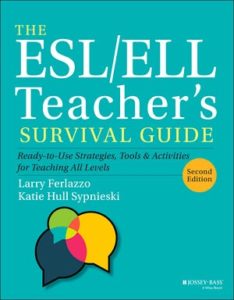A Book to Help ELLs and Their Teachers Thrive
A MiddleWeb Blog

After a stint in the non-profit sector, I’m in my third year back in school with ENL kids. I’d forgotten how much I love them – and, it turns out, I needed a refresher on a bunch of ENL content as well.
Enter Larry Ferlazzo and Katie Hull Sypnieski’s The ESL/ELL Teacher’s Survival Guide, now published in its second edition. It is a beast of a book, clocking in at 552 pages written in six parts and bonus web content. But don’t let this deter you: for the right audience, it is an accessible and useful compendium of the deep practical knowledge of these two highly experienced educators, plus supporting content from 10 other ENL experts.
(Since this is beginning to look like a review, here’s my full disclosure: In the past I have written for Larry Ferlazzo’s EdWeek blog and appeared on his podcast.)

Nor is it an in-depth treatise on second language acquisition, ENL pedagogical research, or ELL population growth. The book works hard to give you the best and brightest of this information, but its real richness lies elsewhere. (As it turns out, though, this concision results in several short and sweet photocopy-worthy sections that could be shared fruitfully with any colleague.)
The book is also centered almost completely on what we call in New York State “stand alone instruction” – that is, ENL instruction that is self-contained and/or contained in a content-area classroom headed up by a content-area teacher. (On page 419 the authors state clearly, “we have zero experience with co-teaching.”) While the book does discuss other ELL program models, it does so only briefly.
This is why two years ago, when I was working with K-3 ELL students in a co-teaching model, the first edition of this book mostly stayed on my bookshelf. Now that I’m back in a middle school hybrid ENL model, however, I found a dozen or more tips, techniques, and lesson ideas in the book that I could put into place tomorrow, literally within only the first few pages.
By working teachers, for working teachers
That the book is written and organized by living, breathing, currently working classroom teachers who know what other teachers need is evident.
The first section, “Getting Started,” covers both the basics of the wider ENL landscape and the ideal ENL classroom with efficacy and grace. Its “3 R’s” for the effective ENL classroom – relationships, resources, and routines – are solid gold, and walk their talk by immediately providing tangible practices and procedures for all three. It also provides a simple guide to the 6,000 acronyms associated with teaching English Language Learners. (It might be a little less than 6000.)
The second section addresses what may be the most urgent question of all for an ENL teacher: “What do I do if my student doesn’t speak any English?” Here the book not only gives you all the key elements of a curriculum for new language learners, it also maps those elements out for you in a model unit plan. This kind of neat and thoroughly practical packaging is one of the great strengths of the book. It truly is a resource that can help an ENL teacher survive – and even thrive.
I’m still reading!
Part II of this post [available here] covers Sections 3-6 of The ESL/ELL Teacher’s Survival Guide. Stay tuned!






























